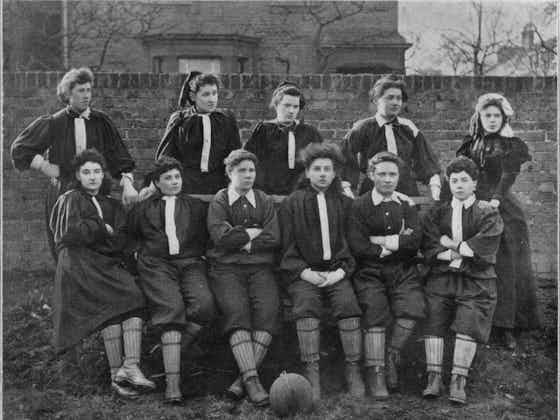She Kicks Magazine
·4 December 2021
LONG READ: 100 Years Since the Ban – ‘When Women’s Football in England Challenged the Men’s Game’

She Kicks Magazine
·4 December 2021

To mark 100 years since The FA’s ban of women’s football on FA affiliated grounds, we’re delighted to share Tony Leighton‘s piece about
They may sound like a contemporary pop group espousing girl power, but ‘The Munitionettes’ were in fact a country-wide sisterhood of First World War factory workers handed the affectionate nickname as they kicked off a quite sensational surge in women’s football that would rock the men’s game in England.
For a glorious decade around the Football Association’s infamous pronouncement that, “the game of football is quite unsuitable for females,” the ladies of the land showed that they actually could play the game – and attract crowds to match some of the biggest men’s teams of the era.
The explosive impact made by The Munitionettes was not the first flowering of women’s football in the UK, games having been reported in 1881 between teams representing England and Scotland in Edinburgh and Glasgow while in 1894 the British Ladies Football Club was founded by the aptly named Nettie Honeyball.

1895 – the British Ladies’ Football Club (North team) Standing: Lily Lynn, Nettie Honeyball, Williams, Edwards, Ide. Seated: Compton, F. B. Fenn, Nellie Gilbert, P. Smith, Rosa Thiere, Biggs.
A sign of what was to follow in terms of the women’s game’s now almost forgotten popularity of the time was the first British Ladies FC-organised match, a North v South meeting at London’s Crouch End in March 1895. The North won 7-1 but, more significantly, a crowd of around 10,000 witnessed the contest.
Outlining her vision for the future the BLFC’s president, Lady Florence Dixie, said in a Pall Mall Gazette article: “If the British public will only give encouragement to the idea, which is now being put into practice, of football for women it will soon take a firm hold and become an approved custom.”

1895 – the British Ladies’ Football Club (South team) Standing: -, Clarke, A. Hicks, Edwards, Clarence. Seated on bench: Hicks, A. F. Lewis, Ellis, A. J. Lewis seated on ground: Eva Roberts, Fenn.
A couple of decades later Lady Florence’s words seemed to be ringing true as the women of England, taking up jobs vacated by the men-folk who were now involved in The Great War, took to the football field while the country’s fighting servicemen were on the battlefield.
At factories all around the country there were women who during lunch breaks would kick a ball around the work yard, initially as a fun way to pass the time between working hours but increasingly with the idea of putting together teams that could play against each other in a novel way to help the war effort.
A high proportion of the matches was organised in order to raise funds for wartime charities, many of which benefited from the efforts of teams competing mainly against local rivals though there were also sides that travelled around the UK and even, after the war, played abroad.
The most famous and successful of these teams was formed in 1917 at Dick, Kerr & Co Ltd, a Preston based company which before the war had manufactured trams and railway rolling stock but that in 1915 converted to the production of ammunition and subsequently boosted its level of female employees.
The Dick, Kerr Ladies were to become internationally known as the flag bearers for English women’s football, but their formation and growth of the game in the north west of England was already being replicated through a loose network of teams playing in the north east, the midlands and the south.

1918 – Wallsend Slipway Ladies F.C.
Up on the north east coast the Wallsend Slipway and Engineering Company, whose female workers’ duties on the Blyth docks included loading ships with ammunition for the front, was the birthplace of what became the region’s leading team, Blyth Spartans Ladies FC.
Blyth Spartans not only ruled the roost amongst women’s teams in their own domain but also took on a men’s side made up of Royal Navy personnel who had been coaching them – giving the ladies, in the words of a Blyth News reporter, ‘a thorough initiation into the art of controlling the elusive pigskin.’

1918 – Blyth Spartans Munition Girls – Munitionette Cup Winners. Back row: Hannah Weir, Lizzie James, Nellie Fairless . Centre row: Agnes Sample, Martha O’Brien, Bella Metcalfe. Front row: Dollie Allan, Annie Allan, Bella Reay, Ada Reed(?), Jennie Morgan . (Photograph courtesy of Yvonne Crawford.)
The girls mastered the art pretty well, beating the ‘Jack Tars’ 7-2 in August 1917. That’s some scoreline, though it should perhaps be added that, as in most similar encounters of the time, each of the outfield male players had both hands tied behind his back while the goalkeeper was allowed the use of just one arm.
The interest generated through this and the many games between local women’s teams that were now taking place led to the establishment of The Munitionettes Cup – officially and somewhat cumbersomely titled ‘The Tyne Wear & Tees Alfred Wood Munition Girls Cup’ – in whose first final Spartans beat Bolckow 5-0 in front of a 22,000 crowd at Middlesbrough FC’s Ayresome Park.
That huge attendance, and the money raised through it for charity, was being mirrored at women’s matches across the country with encouragement coming from quarters as high as the office of the Prime Minister, David Lloyd George, who saw the fixtures as morale boosting events in those severely harsh times.
In December 1920, just over two years after the end of hostilities, the Secretary of State for War – Winston Churchill, no less – even took a hand in the staging of a Dick, Kerr Ladies match at Deepdale, the home of Preston North End FC, an encounter that was a trailblazer for floodlit football.
Permission was sought from and granted by Churchill for the use of anti-aircraft searchlights and carbide flares to light up a game that was filmed by Pathe News and in which Dick, Kerr’s beat the Rest of England 4-0. And with 12,000 spectators watching, over £600 – around £27,500 in today’s money* – was raised for the Unemployed Ex-Servicemen’s Distress Fund.
Ten days later, on Boxing Day 1920, came a watershed moment in the history of the women’s game as 53,000 people packed into Everton’s Goodison Park – with thousands locked outside – to watch Dick, Kerr’s beat local side St Helens 4-0 and this time raise over £3,000 (around £137,500 in today’s money) for charity.
The attendance remains the highest ever for a women’s club match in England and was not bettered at international level until 2012, when a crowd of 70,584 was at Wembley for Great Britain’s 1-0 Olympic Games win against Brazil.

1921 – Dick, Kerr and St Helen’s at Coventry, 26th February 1921.
Dick, Kerr’s and women’s football were, in modern parlance, flying. They were almost certainly within touching distance of establishing the game as a viable spectator sport; but that extraordinary Boxing Day on Merseyside proved to be the turning point in the females’ footballing fortunes.
It did not seem that way immediately, 1921 bringing matches for both Dick, Kerr’s and Stoke Ladies against a representative France team. Dick, Kerr’s, who had also met the French in 1920, reciprocated with fixtures in Paris and Rouen.
As the game was growing so were its personalities, several players becoming widely known and the Dick, Kerr’s sharpshooting left winger Lily Parr approaching superstar status for what have become legendary exploits.
Just 14 when she joined Dick, Kerr’s, Parr scored 43 times in her first season and went on to hit over 900 goals in a 32-year career. She famously chain-smoked Woodbine cigarettes, packs of which she insisted on receiving as part of her payment for playing, and was reputed to have a shot as powerful as any man’s.
But by the time she finished playing her name was virtually forgotten, as were the heights that women’s football had reached before a fateful December day in 1921 when the Football Association effectively banned the game just as Dick, Kerr’s were completing an outstanding year in which they played 67 matches attended by a total of 900,000 spectators.
Perhaps worried at the adverse affect that the popularity of women’s matches might have on the men’s game, and hinting at allegations of financial impropriety – never proved – by the organisers of fundraising games for charity, the FA dealt female football a hammer blow from which it never truly recovered until the governing body rescinded its move 50 years later.
Announcing that, “Complaints having been made as to football being played by women, the council feel impelled to express their strong opinion that the game of football is quite unsuitable for females and ought not to be encouraged,” the FA decreed that none of its affiliated clubs should allow women’s matches to be played on their grounds.
The FA edict meant that ladies’ teams were denied access to practically every football ground in the country, negating their ability to draw big crowds. The Draconian measure stunned everyone involved in the women’s game, but there was an immediate and defiant reaction.
Five days after the FA’s December 5th proclamation a meeting held in Blackburn, where around 30 clubs were in attendance, led to the formation of the English Ladies Football Association and the establishment of the ELFA Challenge Cup.
In London during the same month Lyons Ladies FC organised an exhibition match, between teams from the Strand Corner House and the Regent Palace Hotel, inviting the press along to, “form an opinion of the desirability of ladies playing the game.” The generally shared opinion after the match was that football was no more strenuous for women than sports such as tennis or hockey.

1922 – Stoke Ladies, E.L.F.A. Cup Winners . Back row: Mrs. Amelia Bridgett, Lizzie Smith, Dolly Cooper, Lily Brindley, Lizzie Carroll, Gladys Bridgett, Len Bridgett. Centre row: Hilda Durber, -, Daisy Bates, Elsie Stanier, Ida Bridgett . Front row: Tilly Wagg, Eva Bridgett . (Photograph courtesy of Jayne Bridgett.)
Meanwhile Alfred Frankland, an office worker at Dick, Kerr & Co Ltd and the man who had managed the women’s team from its inception, insisted: “The team will continue to play, if the organisers of charity matches will provide grounds, even if we have to play on ploughed fields.”
As the ELFA Cup’s inaugural season unfolded with teams from Newcastle in the north east to Plymouth in the south west competing, Frankland – who back in 1918 had suggested forming a women’s league in Lancashire – was planning an expansion of Dick, Kerr’s footballing activities on a global scale.
A tour of Canada and the USA was set up and proved quite a success after an inauspicious start. When the ladies arrived in Quebec in December 1922 it was to learn that they had been banned by the Dominion Football Association – with a nudge, it was rumoured, from the FA at home – from facing Canadian teams.
So on they went to America, where there was another surprise awaiting. Rather than being pitted against fellow females, the Dick, Kerr girls discovered, it was mainly men’s teams that would form the opposition during a tour that took them to Boston, Baltimore, St. Louis, Washington, Detroit, Chicago and Philadelphia.
Frankland’s players met the challenge with aplomb, losing only three of the nine games they played during a tour in which they were feted throughout. Celebrities including Hollywood stars lined up to meet them and the nation’s President, Warren Harding, kicked off one of their matches in Washington.
It was a different scenario that Dick, Kerr’s stepped back into on their return to England, where the women’s game – minus the facilities withdrawn by the FA – was going into decline despite the best efforts of team organisers and players.
A continually dwindling number of teams was able to arrange charity games, while the high hopes which followed the birth of the ELFA were dashed as the Challenge Cup failed to last beyond its first season and a league structure never came close to being formulated.
But there were still pockets of the country where the game and its charitable soul occasionally flourished. In the north east, where in 1921 several teams had played fundraising games in aid of striking miners, a Darlington team was formed in 1927 to help boost the Miners’ Boot Fund.
Two years later, and for the same cause, a Good Friday game was contested between teams from the local branches of Woolworths and Marks & Spencer.
And Dick, Kerr’s were still operating, though as Preston Ladies after the company were taken over by English Electric. They proved themselves time and again to be the best team in England and in 1937 won the grandly titled ‘Championship of Great Britain and the World’ with a 5-1 victory over Edinburgh Ladies.
Preston also turned out as England in several international challenge matches through to the 1950’s, but they finally disbanded in 1965 – ironically, 12 months before the resurgence in the women’s game which was inspired by the World Cup triumph of the England men’s team.
The Women’s Football Association was formed in 1969 and controlled the game until the FA took charge in 1993. The growth which has followed has resulted in an England team that competes on the world stage, a professional Super League and a massively thriving grassroots scene.
The Munitionettes, for all their footballing finesse and fighting spirit, could only dream of such a structure and its opportunities….
*Bank of England estimate
For some of the background to this story I acknowledge the research of scholars and authors including Gail Newsham, Jean Williams, Patrick Brennan, David J. Williamson, Sue Lopez and John Simkin.
With She Kicks’ Thanks to Patrick Brennan for the kind permission to use images he has collated and curated on his brilliant historical website, which we would recommend checking out: http://donmouth.co.uk/womens_football/womens_football.html






























































